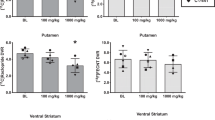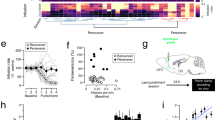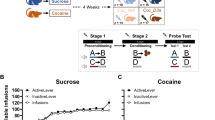Abstract
The dopamine (DA) D1 receptor (D1R) is critically involved in reward and drug addiction. Phosphorylation-mediated desensitization or internalization of D1R has been extensively investigated. However, the potential for upregulation of D1R function through phosphorylation remains to be determined. Here we report that acute cocaine exposure induces protein kinase D1 (PKD1) activation in the rat striatum, and knockdown of PKD1 in the rat dorsal striatum attenuates cocaine-induced locomotor hyperactivity. Moreover, PKD1-mediated phosphorylation of serine 421 (S421) of D1R promotes surface localization of D1R and enhances downstream extracellular signal-regulated kinase signaling in D1R-transfected HEK 293 cells. Importantly, injection of the peptide Tat-S421, an engineered Tat fusion-peptide targeting S421 (Tat-S421), into the rat dorsal striatum inhibits cocaine-induced locomotor hyperactivity and injection of Tat-S421 into the rat hippocampus or the shell of the nucleus accumbens (NAc) also inhibits cocaine-induced conditioned place preference (CPP). However, injection of Tat-S421 into the rat NAc shell does not establish CPP by itself and injection of Tat-S421 into the hippocampus does not influence spatial learning and memory. Thus, targeting S421 of D1R represents a promising strategy for the development of pharmacotherapeutic treatments for drug addiction and other disorders that result from DA imbalances.
Similar content being viewed by others
Log in or create a free account to read this content
Gain free access to this article, as well as selected content from this journal and more on nature.com
or
References
Anderson SM, Bari AA, Pierce RC (2003). Administration of the D1-like dopamine receptor antagonist SCH-23390 into the medial nucleus accumbens shell attenuates cocaine priming-induced reinstatement of drug-seeking behavior in rats. Psychopharmacology 168: 132–138.
Aragona BJ, Cleaveland NA, Stuber GD, Day JJ, Carelli RM, Wightman RM (2008). Preferential enhancement of dopamine transmission within the nucleus accumbens shell by cocaine is attributable to a direct increase in phasic dopamine release events. J Neurosci 28: 8821–8831.
Bateup HS, Santini E, Shen W, Birnbaum S, Valjent E, Surmeier DJ et al (2010). Distinct subclasses of medium spiny neurons differentially regulate striatal motor behaviors. Proc Natl Acad Sci USA 107: 14845–14850.
Bateup HS, Svenningsson P, Kuroiwa M, Gong S, Nishi A, Heintz N et al (2008). Cell type-specific regulation of DARPP-32 phosphorylation by psychostimulant and antipsychotic drugs. Nat Neurosci 11: 932–939.
Beaulieu JM, Gainetdinov RR (2011). The physiology, signaling, and pharmacology of dopamine receptors. Pharmacol Rev 63: 182–217.
Bertran-Gonzalez J, Bosch C, Maroteaux M, Matamales M, Herve D, Valjent E et al (2008). Opposing patterns of signaling activation in dopamine D1 and D2 receptor-expressing striatal neurons in response to cocaine and haloperidol. J Neurosci 28: 5671–5685.
Bisbal M, Conde C, Donoso M, Bollati F, Sesma J, Quiroga S et al (2008). Protein kinase d regulates trafficking of dendritic membrane proteins in developing neurons. J Neurosci 28: 9297–9308.
Chen J, Wersinger C, Sidhu A (2003). Chronic stimulation of D1 dopamine receptors in human SK-N-MC neuroblastoma cells induces nitric-oxide synthase activation and cytotoxicity. J Biol Chem 278: 28089–28100.
Chen R, Tilley MR, Wei H, Zhou F, Zhou FM, Ching S et al (2006). Abolished cocaine reward in mice with a cocaine-insensitive dopamine transporter. Proc Natl Acad Sci USA 103: 9333–9338.
Di Chiara G, Bassareo V (2007). Reward system and addiction: what dopamine does and doesn't do. Curr Opin Pharmacol 7: 69–76.
Exley R, McIntosh JM, Marks MJ, Maskos U, Cragg SJ (2012). Striatal alpha5 nicotinic receptor subunit regulates dopamine transmission in dorsal striatum. J Neurosci 32: 2352–2356.
Fricks-Gleason AN, Marshall JF (2011). Role of dopamine D1 receptors in the activation of nucleus accumbens extracellular signal-regulated kinase (ERK) by cocaine-paired contextual cues. Neuropsychopharmacology 36: 434–444.
Fu Y, Ren M, Feng H, Chen L, Altun ZF, Rubin CS (2009). Neuronal and intestinal protein kinase d isoforms mediate Na+ (salt taste)-induced learning. Sci Signal 2: ra42.
Futaki S (2005). Membrane-permeable arginine-rich peptides and the translocation mechanisms. Adv Drug Deliver Rev 57: 547–558.
Gainetdinov RR, Premont RT, Bohn LM, Lefkowitz RJ, Caron MG (2004). Desensitization of G protein-coupled receptors and neuronal functions. Annu Rev Neurosci 27: 107–144.
Gardner B, Liu ZF, Jiang D, Sibley DR (2001). The role of phosphorylation/dephosphorylation in agonist-induced desensitization of D1 dopamine receptor function: evidence for a novel pathway for receptor dephosphorylation. Mol Pharmacol 59: 310–321.
Giros B, Jaber M, Jones SR, Wightman RM, Caron MG (1996). Hyperlocomotion and indifference to cocaine and amphetamine in mice lacking the dopamine transporter. Nature 379: 606–612.
Iwata M, Maturana A, Hoshijima M, Tatematsu K, Okajima T, Vandenheede JR et al (2005). PKCepsilon-PKD1 signaling complex at Z-discs plays a pivotal role in the cardiac hypertrophy induced by G-protein coupling receptor agonists. Biochem Biophys Res Commun 327: 1105–1113.
Ji SP, Zhang Y, Van Cleemput J, Jiang W, Liao M, Li L et al (2006). Disruption of PTEN coupling with 5-HT2C receptors suppresses behavioral responses induced by drugs of abuse. Nat Med 12: 324–329.
Jiang D, Sibley DR (1999). Regulation of D(1) dopamine receptors with mutations of protein kinase phosphorylation sites: attenuation of the rate of agonist-induced desensitization. Mol Pharmacol 56: 675–683.
Kim OJ, Gardner BR, Williams DB, Marinec PS, Cabrera DM, Peters JD et al (2004). The role of phosphorylation in D1 dopamine receptor desensitization: evidence for a novel mechanism of arrestin association. J Biol Chem 279: 7999–8010.
Lamey M, Thompson M, Varghese G, Chi H, Sawzdargo M, George SR et al (2002). Distinct residues in the carboxyl tail mediate agonist-induced desensitization and internalization of the human dopamine D1 receptor. J Biol Chem 277: 9415–9421.
Lee SP, So CH, Rashid AJ, Varghese G, Cheng R, Lanca AJ et al (2004). Dopamine D1 and D2 receptor co-activation generates a novel phospholipase C-mediated calcium signal. J Biol Chem 279: 35671–35678.
Lu L, Koya E, Zhai H, Hope BT, Shaham Y (2006). Role of ERK in cocaine addiction. Trends Neurosci 29: 695–703.
Mason JN, Kozell LB, Neve KA (2002). Regulation of dopamine D(1) receptor trafficking by protein kinase A-dependent phosphorylation. Mol Pharmacol 61: 806–816.
Rankin ML, Sibley DR (2010). Constitutive phosphorylation by protein kinase C regulates D1 dopamine receptor signaling. J Neurochem 115: 1655–1667.
Rex EB, Rankin ML, Ariano MA, Sibley DR (2008). Ethanol regulation of D(1) dopamine receptor signaling is mediated by protein kinase C in an isozyme-specific manner. Neuropsychopharmacology 33: 2900–2911.
Rex EB, Rankin ML, Yang Y, Lu Q, Gerfen CR, Jose PA et al (2010). Identification of RanBP 9/10as interacting partners for protein kinase C (PKC) gamma/delta and the D1 dopamine receptor: regulation of PKC-mediated receptor phosphorylation. Mol Pharmacol 78: 69–80.
Rozengurt E (2011). Protein kinase D signaling: multiple biological functions in health and disease. Physiology (Bethesda) 26: 23–33.
Rozengurt E, Rey O, Waldron RT (2005). Protein kinase D signaling. J Biol Chem 280: 13205–13208.
Schmitt KC, Reith ME (2010). Regulation of the dopamine transporter: aspects relevant to psychostimulant drugs of abuse. Ann NY Acad Sci 1187: 316–340.
Seif T, Makriyannis A, Kunos G, Bonci A, Hopf FW (2011). The endocannabinoid 2-arachidonoylglycerol mediates D1 and D2 receptor cooperative enhancement of rat nucleus accumbens core neuron firing. Neurosci 193: 21–33.
Shorter D, Kosten TR (2011). Novel pharmacotherapeutic treatments for cocaine addiction. BMC Med 9: 119.
Sidhu A, Fishman PH (1990). Identification and characterization of functional D1 dopamine receptors in a human neuroblastoma cell line. Biochem Biophys Res Commun 166: 574–579.
Steinberg SF (2012). Regulation of protein kinase D1 activity. Mol Pharmacol 81: 284–291.
Stetler RA, Gao Y, Zhang L, Weng Z, Zhang F, Hu X et al (2012). Phosphorylation of HSP27 by protein kinase D is essential for mediating neuroprotection against ischemic neuronal injury. J Neurosci 32: 2667–2682.
Suto N, Wise RA (2011). Satiating effects of cocaine are controlled by dopamine actions in the nucleus accumbens core. J Neurosci 31: 17917–17922.
Wang Y, Kedei N, Wang M, Wang QJ, Huppler AR, Toth A et al (2004). Interaction between protein kinase Cmu and the vanilloid receptor type 1. J Biol Chem 279: 53674–53682.
Xing BM, Yang YR, Du JX, Chen HJ, Qi C, Huang ZH et al (2012). Cyclin-dependent kinase 5 controls TRPV1 membrane trafficking and the heat sensitivity of nociceptors through KIF13B. J Neurosci 32: 14709–14721.
Xu M, Hu XT, Cooper DC, Moratalla R, Graybiel AM, White FJ et al (1994). Elimination of cocaine-induced hyperactivity and dopamine-mediated neurophysiological effects in dopamine D1 receptor mutant mice. Cell 79: 945–955.
Yang YR, He Y, Zhang Y, Li Y, Li Y, Han Y et al (2007). Activation of cyclin-dependent kinase 5 (Cdk5) in primary sensory and dorsal horn neurons by peripheral inflammation contributes to heat hyperalgesia. Pain 127: 109–120.
Yin DM, Huang YH, Zhu YB, Wang Y (2008). Both the establishment and maintenance of neuronal polarity require the activity of protein kinase D in the Golgi apparatus. J Neurosci 28: 8832–8843.
Yuan J, Slice LW, Gu J, Rozengurt E (2003). Cooperation of Gq, Gi, and G12/13 in protein kinase D activation and phosphorylation induced by lysophosphatidic acid. J Biol Chem 278: 4882–4891.
Zhang Y, Su P, Liang P, Liu T, Liu X, Liu XY et al (2010). The DREAM protein negatively regulates the NMDA receptor through interaction with the NR1 subunit. J Neurosci 30: 7575–7586.
Zhen X, Uryu K, Wang HY, Friedman E (1998). D1 dopamine receptor agonists mediate activation of p38 mitogen-activated protein kinase and c-Jun amino-terminal kinase by a protein kinase A-dependent mechanism in SK-N-MC human neuroblastoma cells. Mol Pharmacol 54: 453–458.
Zhu H, Yang Y, Zhang H, Han Y, Li Y, Zhang Y et al (2008). Interaction between protein kinase D1 and transient receptor potential V1 in primary sensory neurons is involved in heat hypersensitivity. Pain 137: 574–588.
Zugaza JL, Waldron RT, Sinnett-Smith J, Rozengurt E (1997). Bombesin, vasopressin, endothelin, bradykinin, and platelet-derived growth factor rapidly activate protein kinase D through a protein kinase C-dependent signal transduction pathway. J Biol Chem 272: 23952–23960.
Acknowledgements
This work was supported by grants from the National Natural Science Foundation of China (91332119, 81161120497, 30925015, and 30830044 to YW; 31371143 and 30900582 to YZ; and 81221002 to LL) and a grant from the Ministry of Science and Technology of China (973 Program: 2014CB542204 to YW).
Author information
Authors and Affiliations
Corresponding author
Additional information
Supplementary Information accompanies the paper on the Neuropsychopharmacology website
Supplementary information
Rights and permissions
About this article
Cite this article
Wang, N., Su, P., Zhang, Y. et al. Protein Kinase D1-Dependent Phosphorylation of Dopamine D1 Receptor Regulates Cocaine-Induced Behavioral Responses. Neuropsychopharmacol 39, 1290–1301 (2014). https://doi.org/10.1038/npp.2013.341
Received:
Revised:
Accepted:
Published:
Issue date:
DOI: https://doi.org/10.1038/npp.2013.341
Keywords
This article is cited by
-
Neurotoxicity Assessment of 1-[(2,3-Dihydro-1-Benzofuran-2-yl)Methyl]Piperazine (LINS01 Series) Derivatives and their Protective Effect on Cocaine-Induced Neurotoxicity Model in SH-SY5Y Cell Culture
Neurotoxicity Research (2022)
-
Reward sensitivity deficits in a rat model of compulsive eating behavior
Neuropsychopharmacology (2020)
-
Combined Effects of Simultaneous Exposure to Caffeine and Cocaine in the Mouse Striatum
Neurotoxicity Research (2016)
-
Disruption of dopamine D1 receptor phosphorylation at serine 421 attenuates cocaine-induced behaviors in mice
Neuroscience Bulletin (2014)



